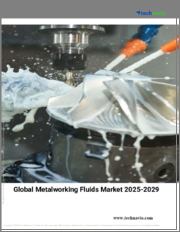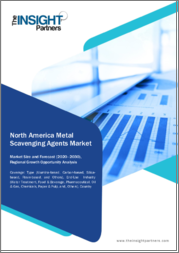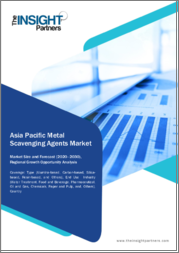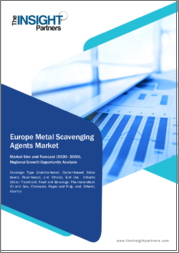
|
시장보고서
상품코드
1403546
세계 금속 제거제 시장 예측(-2030년) : 유형별, 금속 유형별, 용도별, 최종 사용자별, 지역별 분석Metal Scavenging Agents Market Forecasts to 2030 - Global Analysis By Type, Metal Type, Application, End User and By Geography |
||||||
Stratistics MRC에 따르면 세계 금속 제거제 시장은 2023년에 180억 2,000만 달러를 차지했고, 2030년에는 CAGR 7.1%로 성장하여 291억 3,000만 달러에 이를 것으로 예측됩니다.
금속 제거제는 과량의 금속 착물과 반응하여 결합하도록 설계된 기능성 실리카 젤입니다. 금속 제거제는 항공기 캐빈의 촉매 컨버터, 캐소드 재료, 연료 불활성화, e-모빌리티 등 폭넓은 용도가 있습니다. 또한 차세대 기술을 위한 솔루션도 제공합니다. 금속 제거제로 알려진 기능화 재료는 폐기물의 흐름과 동적 의약품의 개선으로 잔류 금속을 조사할 수 있습니다.
유엔에 따르면 세계 도시 인구는 2050년까지 68%를 나타낼 것으로 예상됩니다. 이러한 급속한 도시화는 산업 활동과 폐수 생성 증가와 함께 금속 오염 수준의 상승으로 이어집니다.
고품질 제품에 대한 수요 증가
전자기기 제조, 의약품, 식음료 등 다양한 산업에서는 품질 기준이 엄격하며 공정에서 금속 오염을 최소화해야 합니다. 금속 제거제는 원료, 수원, 제조 공정에서 미량 금속 불순물을 효과적으로 제거함으로써 제품의 품질을 확보하는데 있어서 매우 중요한 역할을 하고 있습니다. 이러한 고품질 제품에 대한 수요는 소비자의 건강과 안전에 대한 의식이 높아짐에 따라 증폭되고 업계는 제품의 품질을 가능한 한 높게 유지하도록 요구되고 있습니다. 그 결과 기업은 이러한 품질 요구 사항을 충족하는 효율적이고 신뢰할 수 있는 솔루션을 찾고 산업의 혁신과 확장이 촉진되므로 시장은 지속적인 성장을 이루고 있습니다.
높은 비용
금속 제거제 시장에서는 높은 비용이 큰 억제요인이 되었습니다. 많은 효과적인 금속 제거제, 특히 고급 및 특수 제형은 제조 및 사용에 비용이 많이 듭니다. 이러한 약물을 필요로 하는 산업 및 용도는 특히 대량으로 사용하는 경우 운영 비용을 관리하는 문제에 직면할 수 있습니다. 게다가 이 비용 요인은 기업과 지자체에 따라 효율적인 금속 제거 솔루션의 도입을 주저하고 환경 규제를 준수하지 않을 수 있습니다.
나노기술의 발전
나노기술은 금속 제거제의 성능을 크게 향상시킬 수 있는 고효율, 선택성의 비재료의 개발을 가능하게 합니다. 나노기술은 금속 제거제의 성능을 크게 향상시키는 고효율의 선택성이 높은 비재료의 개발을 가능하게 합니다. 나노기술은 표면 개질과 작용기화를 조절할 수 있어 다양한 용도로 금속 특화된 흡착제를 설계할 수 있습니다. 이 기술 혁신은 수처리, 환경 복구, 전자 장비 제조와 같은 산업에서 특히 중요한 보다 비용 효율적이고 환경 친화적인 금속 제거 솔루션으로 이어질 수 있습니다. 나노테크놀로지가 계속해서 진보하는 동안, 금속 제거제 시장은 이러한 첨단 개발로부터 혜택을 누릴 수 있는 좋은 위치에 있으며, 금속 이온 제거 공정에서 효율성과 지속가능성 향상을 제공합니다.
엄격한 규정
규제는 환경 보호와 공공 안전을 위해 필요한 것이지만, 더 엄격한 컴플라이언스 요건과 더 많은 시험 요건을 부과할 수 있으며, 금속 제거제를 사용하는 사업의 운영 비용을 증가시킬 수 있습니다. 게다가, 규제 환경의 변화는 보다 지속가능하고 친환경적인 해결책으로 이어질 수 있으며, 이는 이 분야가 R&D에 자금을 지출하도록 촉구할 수 있습니다. 따라서 이러한 규제는 시장 확대의 큰 장벽이 됩니다.
COVID-19의 영향
COVID-19의 대유행은 금속 제거제 시장에 다양한 영향을 미쳤습니다. 한 업계에서는 수요가 급증했지만 다른 업계에서는 생산과 공급망이 혼란스러웠습니다. 제약업계 수요가 급증한 결과, 금속 제거제의 필요성이 높아졌습니다. 그러나 생산량의 감소나 불안정한 경제 상황 때문에 일렉트로닉스나 자동차 산업 등의 섹터는 어려움을 깨달았습니다. 전반적으로 시장은 유연한 것으로 입증되었으며 경제가 안정됨에 따라 개선이 예상됩니다.
알루미나계 부문이 예측 기간 동안 최대가 될 전망
알루미나계 부문이 최대 점유율을 차지하는 것으로 추정됩니다. 알루미나 기반 약물은 다양한 금속 이온에 대한 탁월한 친화력으로 알려져 있으며 금속 제거 공정에서 매우 효과적입니다. 이러한 약제는 중금속 오염이 큰 우려사항인 폐수처리, 광업, 야금 등의 산업에서 널리 사용되고 있습니다. 게다가, 그 범용성과 금속 흡착 능력의 높이로부터, 산업용수의 정화나 환경 수복등의 용도에 빠뜨릴 수 없는 것이 되고 있습니다. 알루미나 기반 금속 제거제는 환경 규제 준수 및 유해 금속 제거를 보장하는 데 중요한 역할을 하며, 보다 안전하고 지속 가능한 산업 공정과 깨끗한 수원에 기여합니다.
수처리 분야는 예측기간 중 가장 높은 CAGR이 예상된다.
수처리 분야는 예측 기간 동안 유리한 성장이 예상됩니다. 금속 제거제는 수원에서 금속 이온의 존재를 제거하고 제어하기 위해 이 분야에서 널리 채택됩니다. 이 처리 과정은 식수 안전, 산업 폐수 규정 준수 및 환경 오염 최소화를 보장합니다. 또한, 다양한 킬레이트제, 수지, 흡착제를 비롯한 이러한 약물은 중금속 포착, 오염 방지, 공중 보건 보호에 중요한 역할을 합니다. 수질에 대한 우려가 증가하고 규제가 엄격해짐에 따라 수처리 분야에서 금속 제거제 수요가 계속 증가하고 있으며, 업계의 기술 혁신과 지속가능성에 대한 노력을 추진하고 있습니다.
최대 점유율을 차지하는 지역
아시아태평양은 산업화 진전, 환경 규제 강화, 금속 오염 문제에 대한 의식 증가로 예측 기간 동안 최대 시장 점유율을 차지했습니다. 중국과 인도와 같은 국가들은 중금속 오염에 대한 우려를 다루고 있기 때문에 이러한 약물에 대한 수요가 급증하고 있습니다. 또한 이 지역에서는 수처리, 광업, 전자 산업이 확대되고 있으며, 효과적인 금속 이온 제거 솔루션의 필요성이 증가하고 있습니다. 또한 아시아태평양의 자동차, 전자, 화학 산업의 성장은 금속 제거제 수요 증가에 기여하고 있습니다.
CAGR이 가장 높은 지역:
북미는 최첨단 산업 기술과 까다로운 환경법으로 인해 예측 기간 동안 수익성이 높은 성장이 예상됩니다. 이 지역에서는 화학, 의약품, 수처리 등의 중요한 기업이 존재하고 환경의 지속가능성에 중점을 두고 있는 것으로 금속 제거제 수요를 견인하고 있습니다. 미국과 캐나다는 금속거 솔루션의 효율성을 높이기 위한 연구개발에 중점을 두고 있으며 시장 확대의 주요 공헌국입니다. 또한 이 지역의 확립된 인프라와 기술의 발전이 북미의 높은 수익률에 기여하고 있습니다.
사용자 정의 무료 제공:
이 보고서를 구독하는 고객은 다음 무료 맞춤설정 옵션 중 하나를 사용할 수 있습니다.
- 기업 프로파일
- 추가 시장 기업의 종합적 프로파일링(3개사까지)
- 주요 기업의 SWOT 분석(3개사까지)
- 지역 세분화
- 고객의 관심에 응한 주요국 시장 추계, 예측, CAGR(주: 타당성 확인에 따름)
- 경쟁 벤치마킹
- 제품 포트폴리오, 지리적 존재, 전략적 제휴에 기반한 주요 기업 벤치마킹
목차
제1장 주요 요약
제2장 서문
- 개요
- 이해관계자
- 조사 범위
- 조사 방법
- 데이터 마이닝
- 데이터 분석
- 데이터 검증
- 조사 접근
- 조사 소스
- 1차 조사 소스
- 2차 조사 소스
- 전제조건
제3장 시장 동향 분석
- 성장 촉진요인
- 억제요인
- 기회
- 위협
- 용도 분석
- 최종 사용자 분석
- 신흥 시장
- COVID-19의 영향
제4장 Porter's Five Forces 분석
- 공급기업의 협상력
- 구매자의 협상력
- 대체품의 위협
- 신규 참가업체의 위협
- 경쟁 기업간 경쟁 관계
제5장 세계의 금속 제거제 시장 : 유형별
- 알루미나계
- 실리카계
- 카본계
- 수지계
- 기타 유형
제6장 세계의 금속 제거제 시장 : 금속 유형별
- 중금속
- 희토류
- 전이금속
- 방사성 금속
- 기타 금속 유형
제7장 세계의 금속 제거제 시장 : 용도별
- 수처리
- 의약품
- 화학약품
- 식품 및 음료
- 석유 및 가스
- 종이 펄프
- 일렉트로닉스
- 기타 용도
제8장 세계의 금속 제거제 시장 : 최종 사용자별
- 산업용
- 헬스케어
- 마이닝
- 에너지 및 파워
- 항공우주
- 시영
- 기타 최종 사용자
제9장 세계의 금속 제거제 시장 : 지역별
- 북미
- 미국
- 캐나다
- 멕시코
- 유럽
- 독일
- 영국
- 이탈리아
- 프랑스
- 스페인
- 기타 유럽
- 아시아태평양
- 일본
- 중국
- 인도
- 호주
- 뉴질랜드
- 한국
- 기타 아시아태평양
- 남미
- 아르헨티나
- 브라질
- 칠레
- 기타 남미
- 중동 및 아프리카
- 사우디아라비아
- 아랍에미리트(UAE)
- 카타르
- 남아프리카
- 기타 중동 및 아프리카
제10장 주요 발전
- 계약, 파트너십, 협업, 합작투자(JV)
- 인수와 합병
- 신제품 발매
- 사업 확대
- 기타 주요 전략
제11장 기업 프로파일
- BASF SE
- SiliCycle Inc.
- Prochem
- Johnson Matthey
- Biotage
- PhosphonicS Ltd
- SUEZ
- Dow Chemical Company
- Clariant AG
- DuPont de Nemours, Inc.
- WR Grace & Co
- Mitsubishi Chemical Corporation
- Merck KGaA
- Zeochem AG
- Albemarle Corporation
- Purolite Corporation
- Sunresin New Materials Co., Ltd.
- Ecolab Inc.
- Solvay SA
- Samyang Corporation
According to Stratistics MRC, the Global Metal Scavenging Agents Market is accounted for $18.02 billion in 2023 and is expected to reach $29.13 billion by 2030 growing at a CAGR of 7.1% during the forecast period. Metal scavengers are functional silica gels that are designed to react with and bind excess metal complexes. Metal scavenging agents have a wide range of applications, such as catalytic converters for aeroplane cabins, cathode materials, fuel inerting, and e-mobility. It also provides solutions for next-generation technology. Functionalized materials known as metal scavenging agents are able to investigate residual metals from waste streams or dynamic pharmaceutical improvements.
According to the United Nations, the global urban population is expected to reach 68% by 2050. This rapid urbanization is accompanied by increased industrial activities and wastewater generation, leading to higher metal pollution levels.
Market Dynamics:
Driver:
Increasing demand for high-quality products
Various industries, including electronics manufacturing, pharmaceuticals, and food and beverage, have stringent quality standards, requiring minimal metal contamination in their processes. Metal scavenging agents play a pivotal role in ensuring product quality by effectively removing trace metal impurities from raw materials, water sources, and manufacturing processes. This demand for high-quality products is amplified by consumers' growing awareness of health and safety concerns, pushing industries to maintain the highest product quality possible. As a result, the market experiences continuous growth as businesses seek efficient and reliable solutions to meet these quality requirements, fostering innovation and expansion in the industry.
Restraint:
High cost
High costs serve as a significant restraint in the metal scavenging agent market. Many effective metal scavenging agents, particularly advanced and specialised formulations, can be expensive to produce and use. Industries and applications requiring these agents may face challenges in managing operational costs, especially when using large quantities. Moreover, this cost factor can deter some businesses and municipalities from implementing efficient metal removal solutions, potentially leading to non-compliance with environmental regulations.
Opportunity:
Advancements in nanotechnology
Nanotechnology allows for the development of highly efficient and selective nonmaterial that can significantly enhance the performance of metal scavenging agents. It allows for tailored surface modifications and functionalization, making it possible to design metal-specific adsorbents for various applications. This innovation can lead to more cost-effective and environmentally friendly metal removal solutions, which is particularly important in industries such as water treatment, environmental remediation, and electronics manufacturing. As nanotechnology continues to advance, the metal scavenging agent market is well-positioned to benefit from these cutting-edge developments, offering improved efficiency and sustainability in metal ion removal processes.
Threat:
Stringent regulations
Regulations are necessary for both environmental protection and public safety, but they can also impose stricter compliance requirements and more testing requirements, which could increase the operational expenses of businesses that use metal scavenging agents. Furthermore, shifting regulatory environments may leads to more sustainable and environmentally friendly solutions, this might encourage the sector to spend money on R&D. Thus, these regulations act as a significant barrier to market expansion.
COVID-19 Impact
The COVID-19 pandemic has had a mixed impact on the metal scavenging agents market. Demand surged in certain industries while production and supply chains were disrupted in others. Metal scavenging agents became more necessary as a result of the pharmaceutical industry's rapid increase in demand. However, because of lower production and unstable economic conditions, sectors including electronics and the automotive industry noticed difficulties. Overall, the market has proven flexible, and as economies stabilise, an improvement is predicted.
The Alumina-based segment is expected to be the largest during the forecast period
The Alumina-based segment is estimated to hold the largest share. Alumina-based agents are known for their exceptional affinity for various metal ions, making them highly effective in metal removal processes. These agents are extensively used in industries such as wastewater treatment, mining, and metallurgy, where heavy metal contamination is a significant concern. Moreover, their versatility and high capacity for metal adsorption make them indispensable in applications like industrial water purification and environmental remediation. Alumina-based metal-scavenging agents play a vital role in ensuring compliance with environmental regulations and the removal of toxic metals, contributing to safer and more sustainable industrial processes and cleaner water sources.
The Water Treatment segment is expected to have the highest CAGR during the forecast period
The Water Treatment segment is anticipated to have lucrative growth during the forecast period. Metal scavenging agents are employed extensively in this sector to remove and control the presence of metal ions in water sources. The treatment process ensures that drinking water is safe, industrial wastewater is compliant with regulations, and environmental pollution is minimized. In addition, these agents, who can include various chelating agents, resins, and adsorbents, play a vital role in capturing heavy metals, preventing contamination, and safeguarding public health. With increasing concerns about water quality and stricter regulations, the demand for metal scavenging agents in the water treatment segment continues to grow, driving innovation and sustainability efforts in the industry.
Region with largest share:
Asia Pacific commanded the largest market share during the extrapolated period due to increased industrialization, environmental regulations, and growing awareness of metal pollution issues. Countries like China and India are experiencing a surge in demand for these agents as they grapple with heavy metal contamination concerns. Additionally, the region's expanding water treatment, mining, and electronics industries are driving the need for effective metal ion removal solutions. Moreover, the growing automotive, electronics, and chemical industries in the Asia Pacific region contribute to the increased demand for metal scavenging agents.
Region with highest CAGR:
North America is expected to witness profitable growth over the projection period, due to the region's cutting-edge industrial techniques and stringent environmental laws. The demand for metal scavenging agents is driven in this region by the existence of significant companies, including chemicals, pharmaceuticals, and water treatment, as well as the growing emphasis on environmental sustainability. The United States and Canada are the primary contributors to the market's expansion, with a focus on research and development to enhance the effectiveness of metal removal solutions. Additionally, the region's well-established infrastructure and technological advancements contribute to the high revenue percentage in North America.
Key players in the market:
Some of the key players in the Metal Scavenging Agents Market include BASF SE, SiliCycle Inc., Prochem, Johnson Matthey, Biotage, PhosphonicS Ltd, SUEZ, Dow Chemical Company, Clariant AG, DuPont de Nemours, Inc., W. R. Grace & Co, Mitsubishi Chemical Corporation, Merck KGaA, Zeochem AG, Albemarle Corporation, Purolite Corporation, Sunresin New Materials Co., Ltd., Ecolab Inc., Solvay SA, and Samyang Corporation.
Key Developments:
In May 2023, Rio Tinto started working with two technology providers from Finland - Weeefiner and Sensmet - on mine water metal recovery. Weeefiner and Sensmet are focusing on developing water treatment solutions that would be able to recover metals from mining-impacted waters. Weeefiner and Sensmet have collaborated to resolve water treatment challenges posed by end-of-life mining sites. The development project has received funding from Rio Tinto's sustainable water treatment challenge program.
In May 2023, researchers from the Technical University of Munich and the University of Applied Sciences highlighted the potential of biosorption as a promising eco-friendly alternative to conventional REE (rare earth elements) recovery methods.
Types Covered:
- Alumina-based
- Silica-based
- Carbon-based
- Resin-based
- Other Types
Metal Types Covered:
- Heavy Metals
- Rare Earth Metals
- Transition Metals
- Radioactive Metals
- Other Metal Types
Applications Covered:
- Water Treatment
- Pharmaceutical
- Chemical
- Food & Beverage
- Oil & Gas
- Pulp & Paper
- Electronics
- Other Applications
End Users Covered:
- Industrial
- Healthcare
- Mining
- Energy and Power
- Aerospace
- Municipal
- Other End Users
Regions Covered:
- North America
- US
- Canada
- Mexico
- Europe
- Germany
- UK
- Italy
- France
- Spain
- Rest of Europe
- Asia Pacific
- Japan
- China
- India
- Australia
- New Zealand
- South Korea
- Rest of Asia Pacific
- South America
- Argentina
- Brazil
- Chile
- Rest of South America
- Middle East & Africa
- Saudi Arabia
- UAE
- Qatar
- South Africa
- Rest of Middle East & Africa
What our report offers:
- Market share assessments for the regional and country-level segments
- Strategic recommendations for the new entrants
- Covers Market data for the years 2021, 2022, 2023, 2026, and 2030
- Market Trends (Drivers, Constraints, Opportunities, Threats, Challenges, Investment Opportunities, and recommendations)
- Strategic recommendations in key business segments based on the market estimations
- Competitive landscaping mapping the key common trends
- Company profiling with detailed strategies, financials, and recent developments
- Supply chain trends mapping the latest technological advancements
Free Customization Offerings:
All the customers of this report will be entitled to receive one of the following free customization options:
- Company Profiling
- Comprehensive profiling of additional market players (up to 3)
- SWOT Analysis of key players (up to 3)
- Regional Segmentation
- Market estimations, Forecasts and CAGR of any prominent country as per the client's interest (Note: Depends on feasibility check)
- Competitive Benchmarking
- Benchmarking of key players based on product portfolio, geographical presence, and strategic alliances
Table of Contents
1 Executive Summary
2 Preface
- 2.1 Abstract
- 2.2 Stake Holders
- 2.3 Research Scope
- 2.4 Research Methodology
- 2.4.1 Data Mining
- 2.4.2 Data Analysis
- 2.4.3 Data Validation
- 2.4.4 Research Approach
- 2.5 Research Sources
- 2.5.1 Primary Research Sources
- 2.5.2 Secondary Research Sources
- 2.5.3 Assumptions
3 Market Trend Analysis
- 3.1 Introduction
- 3.2 Drivers
- 3.3 Restraints
- 3.4 Opportunities
- 3.5 Threats
- 3.6 Application Analysis
- 3.7 End User Analysis
- 3.8 Emerging Markets
- 3.9 Impact of Covid-19
4 Porters Five Force Analysis
- 4.1 Bargaining power of suppliers
- 4.2 Bargaining power of buyers
- 4.3 Threat of substitutes
- 4.4 Threat of new entrants
- 4.5 Competitive rivalry
5 Global Metal Scavenging Agents Market, By Type
- 5.1 Introduction
- 5.2 Alumina-based
- 5.3 Silica-based
- 5.4 Carbon-based
- 5.5 Resin-based
- 5.6 Other Types
6 Global Metal Scavenging Agents Market, By Metal Type
- 6.1 Introduction
- 6.2 Heavy Metals
- 6.3 Rare Earth Metals
- 6.4 Transition Metals
- 6.5 Radioactive Metals
- 6.6 Other Metal Types
7 Global Metal Scavenging Agents Market, By Application
- 7.1 Introduction
- 7.2 Water Treatment
- 7.3 Pharmaceutical
- 7.4 Chemical
- 7.5 Food & Beverage
- 7.6 Oil & Gas
- 7.7 Pulp & Paper
- 7.8 Electronics
- 7.9 Other Applications
8 Global Metal Scavenging Agents Market, By End User
- 8.1 Introduction
- 8.2 Industrial
- 8.3 Healthcare
- 8.4 Mining
- 8.5 Energy and Power
- 8.6 Aerospace
- 8.7 Municipal
- 8.8 Other End Users
9 Global Metal Scavenging Agents Market, By Geography
- 9.1 Introduction
- 9.2 North America
- 9.2.1 US
- 9.2.2 Canada
- 9.2.3 Mexico
- 9.3 Europe
- 9.3.1 Germany
- 9.3.2 UK
- 9.3.3 Italy
- 9.3.4 France
- 9.3.5 Spain
- 9.3.6 Rest of Europe
- 9.4 Asia Pacific
- 9.4.1 Japan
- 9.4.2 China
- 9.4.3 India
- 9.4.4 Australia
- 9.4.5 New Zealand
- 9.4.6 South Korea
- 9.4.7 Rest of Asia Pacific
- 9.5 South America
- 9.5.1 Argentina
- 9.5.2 Brazil
- 9.5.3 Chile
- 9.5.4 Rest of South America
- 9.6 Middle East & Africa
- 9.6.1 Saudi Arabia
- 9.6.2 UAE
- 9.6.3 Qatar
- 9.6.4 South Africa
- 9.6.5 Rest of Middle East & Africa
10 Key Developments
- 10.1 Agreements, Partnerships, Collaborations and Joint Ventures
- 10.2 Acquisitions & Mergers
- 10.3 New Product Launch
- 10.4 Expansions
- 10.5 Other Key Strategies
11 Company Profiling
- 11.1 BASF SE
- 11.2 SiliCycle Inc.
- 11.3 Prochem
- 11.4 Johnson Matthey
- 11.5 Biotage
- 11.6 PhosphonicS Ltd
- 11.7 SUEZ
- 11.8 Dow Chemical Company
- 11.9 Clariant AG
- 11.10 DuPont de Nemours, Inc.
- 11.11 W. R. Grace & Co
- 11.12 Mitsubishi Chemical Corporation
- 11.13 Merck KGaA
- 11.14 Zeochem AG
- 11.15 Albemarle Corporation
- 11.16 Purolite Corporation
- 11.17 Sunresin New Materials Co., Ltd.
- 11.18 Ecolab Inc.
- 11.19 Solvay SA
- 11.20 Samyang Corporation



















